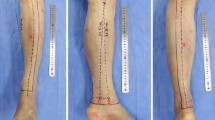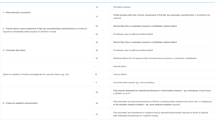Abstract
In this clinical study, the effect of conventional liposuction on musculocutaneous and fasciocutaneous perforator vessels was investigated. The perforator vessels in the abdominal and lateral and medial thigh regions in 7 patients and in the abdominal region in 3 patients (a total of 38 anatomic regions in 10 patients) were marked preoperatively by color Doppler ultrasonography. Following a standard liposuction procedure, the changes in the number of the perforators in those regions were detected by the same method postoperatively at 2 weeks and 3 months. The number of cannula passes employed and total volume of the aspirate for each region were also recorded. The results of the Doppler examinations showed that 57.8% of abdominal, 50.0% of lateral thigh and 53.8% of medial thigh perforators could not be detected at 2 weeks and 3 months (p<0.01) postoperatively. Both the number and the locations of the perforators were found to be identical for each anatomic region at the two postoperative Doppler examinations at 2 weeks and 3 months. The changes in the number of the perforators did not show any type of correlation with the number of cannula passes and the aspirate volume. The results of this study have shown that conventional liposuction may have a traumatic effect on the perforator vessels passing from the deep fascia towards the overlying skin. This observation has led us to suggest that a history of previous liposuction should be an indication for preoperative evaluation of the perforators when a musculocutaneous or fasciocutaneous flap is planned in the suctioned regions. This may prevent problems related with flap viability.
Similar content being viewed by others
References
Dillerud E (1991) Suction lipoplasty: a report on complications, undesired results, and patient satisfaction based on 3511 procedures. Plast Reconstr Surg 88:239
Emeri JF, Krupp S, Doerfl J (1993) Is a free or pedicled TRAM flap safe after liposuction? Plast Reconstr Surg 92:1198
Hallock GG (1994) Evaluation of fasciocutaneous perforators using color duplex imaging. Plast Recontr Surg 94:644
Ozean G, Shenaq S, Baldwin B, Spira M (1991) The trauma of suction-assisted lipectomy cannula on flap circulation in rats. Plast Reconstr Surg 88:250
Rand RP, Cramer MM, Strandness DE Jr (1994) Color-flow duplex scanning in the preoperative assessment of TRAM flap perforators. a report of 32 consecutive patients. Plast Reconstr Surg 93:453
Teimoiurian B, Adham MN, Gulin S, Shapiro C (1983) Suction lipectomy: a review of 200 patients over a six-year period and a study of the technique in cadavers. Ann Plast Surg 11:93
Teimourian B, Kroll S (1984) Subcutaneous endoscopy in suction lipectomy. Plast Reconstr Surg 74:708
Teimourian B, Rogers WB III (1989) A national survey of complications associated with suction lipectomy: a comparative study. Plast Reconstr Surg 84:628
Author information
Authors and Affiliations
Rights and permissions
About this article
Cite this article
İnceoğlu, S., Özdemir, H., İnceoğlu, F. et al. Investigation of the effect of liposuction on the perforator vessels using color Doppler ultrasonography. Eur J Plast Surg 21, 38–42 (1998). https://doi.org/10.1007/BF01152422
Received:
Accepted:
Issue Date:
DOI: https://doi.org/10.1007/BF01152422




